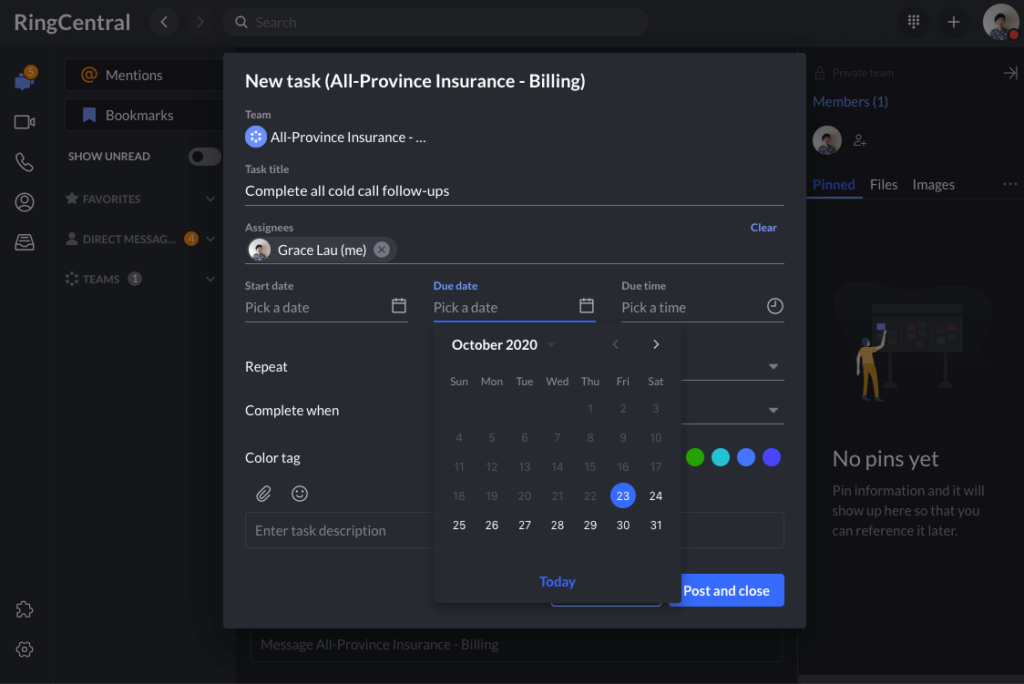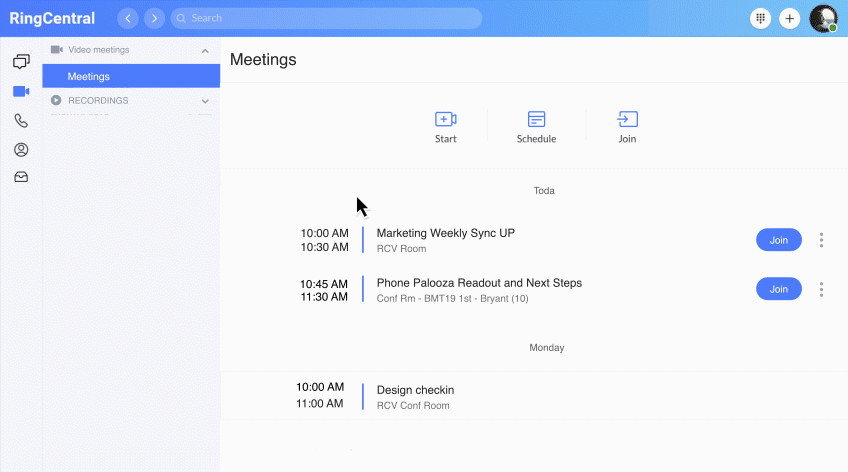Have you ever left a meeting confused about everyone’s action items—yours included?
Okay, that was a rhetorical question. We know you have.
It’s okay—we have, too. Just like every other professional in every other industry.
At RingCentral, we’ve seen and heard it all when it comes to meetings. After all, we work with thousands of small and medium-sized businesses around the world to improve their workforce communications, customer service, and meeting productivity with our innovative communications platforms and technology.
And guess what one of the biggest pain points is for our clients? Yep. Tracking, managing, and completing meeting action items.
In some cases, a company’s meeting follow-up strategy is coming up short. In others, it’s a lack of action item tracking that’s blurring responsibilities and deadlines. Whatever is causing your action item ails, have no fear—we’ve got some ways to help you turn your meeting action items into real action that drives your business forward. Some of them require an investment in planning, attention, and focus, while others require an investment in meeting and communications technology.
Either way, rest assured that by the end of this article, you’ll have specific and actionable ways to start transforming how your company handles meeting action items and next steps.
Ready to dive in? Here’s what comes next:
- Effective action item management starts with a great meeting agenda
- The best way to track action items during and after meetings
- A smart and simple template for follow-up actions after a meeting
- Common meeting action items (and how to make sure they get done)
Use these free meeting agenda templates to have more productive meetings. 👇
Effective action item management starts with a great meeting agenda
Before you can expect meeting action item tracking and follow up to improve at your company, you need to address meetings themselves.
And that starts with the agenda.
Prior to a meeting, having a clear and actionable agenda—in writing—sets the right tone for all attendees. More specifically, an agenda helps attendees prepare for the meeting and gives them an idea of what they should expect to speak about during the scheduled time. It’s kind of like action items in reverse, in the sense that a meeting agenda should outline just about everything everyone needs to do—except in this case it’s during the meeting, not after.
Here are three things a great meeting agenda does:
-
It gives context and explains “why”
By providing some background about a meeting for attendees, specifically around why you’re meeting in the first place, you ground everyone on the same topic and give them a reason to care.
-
It explains how attendees will use the meeting time
The best meetings are both quick and productive, and that’s because they’re set up by agendas that detail how the time will be spent, what will be discussed, and who will be doing what.
-
It describes the end goal of the meeting
Every meeting should accomplish something, yet so many of them don’t. The problem? The agenda doesn’t state a goal. By giving your attendees a well-defined objective in the agenda before the meeting, you can make it everyone’s responsibility to be productive. Plus, having a clearly defined goal in your agenda provides a “North Star” to direct your team during your time together.

The best way to track action items during and after meetings
Make no mistake about it—tracking action items starts well before the end of a meeting.
Meetings move fast and a lot gets said during them, so it’s imperative that each one has a designated notetaker who can keep track of things—not only what’s being said, but also who’s being assigned what and when the work is due.
These days, however, this can be harder than it sounds.
The problem is, most people take notes in one app on their laptop and manage tasks in another. This causes confusion for the notetaker, plus it’s a hassle to constantly toggle between this app and that app—especially during the frenzy of a meeting. Oh, and then you’re supposed to turn those mumble-jumble notes into action items after the fact?
Forget about it.
These are all reasons why we’ve developed an easy-to-use note-taking feature and action item tracker—all within the context of your team conversations within the RingCentral app itself:

Notes allows you to create, edit, and review meeting notes within certain conversations on the app…

While Tasks allows you to manage projects and action items within specific conversations, too:

These two features allow you to track action items in real time and in a shared environment, so all your other meeting attendees have visibility into the same notes and tasks. This gives everyone a shared sense of responsibility and helps each team member stay aligned on follow-up items.
Not to mention RingCentral Notes and Tasks are in the same app as the rest of your RingCentral suite, so you can access them without having to worry about clicking around, opening new windows, and becoming overloaded by a bunch of different browser tabs.
So, when it comes to tracking action items during and after meetings, there’s really nothing quite like Notes and Tasks within the RingCentral app.
A smart and simple meeting notes template with action items
When it comes to follow-up items, there are a few smart, simple actions you can take to make sure a project stays on track and all tasks get completed. Here’s a quick look at just how simple it can be.
| Step | Action Item |
| Step 1 | Review all notes—you and your coworkers’ |
| Step 2 | Send out a recap note outlining meeting details and action items |
| Step 3 | Schedule due date reminders for you and coworkers on an app |
But let’s dive in a bit deeper.
Now, most of these probably seem like common sense—and they are—but far too many companies complicate meeting follow-up. This leads—not to exceptional productivity, but to confusion and chaos (and missed deadlines).
1. Review all notes—yours and your coworkers’
This is as straightforward as it gets. Reviewing all notes after a meeting helps you cover things you may have missed before while also giving you a chance to really understand what has to be done—by who and by when.
2. Send out a recap note outlining meeting details and action items
As a way to cover your bases and make sure every meeting attendee remains accountable, try to make a habit of sending out a recap email. This should detail what was discussed, what agreements were made, and what the next steps are.
Another neat thing about the RingCentral app is that you can create a group chat with the attendees from your meeting! This way, you can easily get everyone in one conversation to discuss follow-ups and results from the meeting:

3. Schedule due date reminders for you and coworkers on an app
Whether it’s on your calendar or the RingCentral app, you should always set due date reminders after a meeting. Why? Because business moves fast, and if you don’t have reminders in place, you and your team could miss vital deadlines.
🕹️ Get a hands-on look at how RingCentral works by booking a product tour:
💰 You can also use this calculator to see roughly how much your business could save by using RingCentral to support your team’s communication with each other—and clients.
Common meeting action items (and how to make sure they get done)
Action items aren’t going anywhere, and some are more common than others. Yet for many of the reasons we’ve already discussed, they still don’t get done all the time.
Not anymore.
Here are some common meeting action items and how to make sure they actually get done in your company.
- Action item: Review project plan.
How to make sure it gets done: Schedule a brief stand-up call on the due date with the team member who is responsible for reviewing it. - Action item: Follow up with the client.
How to make sure it gets done: Ask the person who’s sending the follow-up email to the client to cc (or bcc) you on it. This way, if it gets done, you know it—and if it doesn’t, you can nudge your coworker to remind them. - Action item: Upload documents to a project management tool and/or a file sharing app.
How to make sure it gets done: Ask the assigned team member to let you know when the documents have been uploaded so you can confirm they’re in the right place. - Action item: Get approvals.
How to make sure it gets done: Check in with your point person prior to the deadline to make sure the assigned team member successfully got approvals. - Action item: Schedule follow-up meeting and/or presentation
How to make sure it gets done: This is perhaps the easiest one to track, as it just requires keeping an eye on your email for a calendar invite to come through. If one doesn’t, you’re going to want to gently remind your coworker that they need to set up that meeting before it’s too late.
Turning meeting action items into real action starts now
When it comes to how to track action items and how to complete them, you need to first focus on your attention, then on your effort, and then on your tools and technology. Only then will you be able to truly reap the rewards of effective meeting planning and execution.
However, when you do reap those rewards, you’ll probably be kicking yourself for waiting this long to get your meeting and follow-up strategies in shape. That’s because, at the end of the day, zeroing in on action item tracking and follow-up can be the main difference between having a productive and profitable business versus an ineffective and indebted one.
With that being said—it’s never too late for a business to become productive and profitable.
The only thing is… who would’ve thought it all started with meeting agendas with action items?
Originally published Nov 13, 2020, updated Jun 23, 2021





